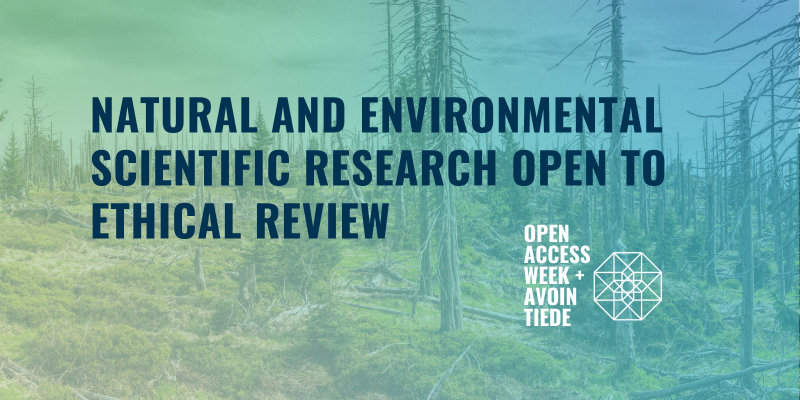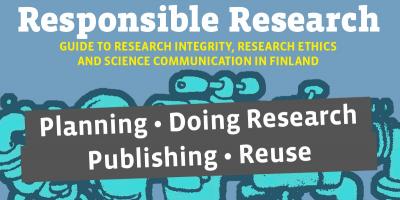Pre-emptive ethics is a tool that can be used to systematically identify and resolve issues of research ethics as a community.
Researchers face ethical challenges at every stage of their work. What should be researched, how should research subjects be asked for consent, how should equipment and materials be obtained, and how, where and when should research outcomes be published? Not to mention how research material should be made open, if at all? The guidelines on Responsible conduct of research and procedures for handling allegations of misconduct in Finland (the RCR guidelines) published by the Finnish National Board on Research Integrity (TENK) set out the values and aims for research conduct. They constitute shared principles and guidelines for the research community.
Pre-emptive ethics, on the other hand, is a tool that can be used to systematically identify and resolve these ethical issues as a community. As its name suggests, the idea is to tackle ethical issues before they cause ethical problems, in other words in good time and systematically as part of the research process.
The fundamental pillars of pre-emptive ethics are ethical analysis and ethical approaches. These can be applied at all stages of research and their use is often cyclical, in other words returning to the same issues several times from different angles.
The fundamental pillars of pre-emptive ethics are ethical analysis and ethical approaches.
One essential part of pre-emptive ethics is that the process is an open one – the aim is to make ethics visible in research. It also gives the researcher as an individual the confidence to justify the ethical solutions made during their research. For the research community, it offers an opportunity to consider ethical issues together, and thus further strengthen the community in producing reliable and acceptable findings.
Ethical analysis
The first step in pre-emptive ethics is an ethical analysis, which is based on the idea that ethical issues are complex and understanding them is a process that involves a number of steps. To understand the issue, it is helpful to examine it from at least three different points of view:
1. Who are the stakeholders, in other words, who affect the research and who is affected by the research?
2. Which legislation, guidelines or rules affect the actions of each stakeholder in the research situation?
3. What alternatives do different stakeholders (especially the researcher themselves) have for resolving the ethical issue?
Asking these questions often enables the actual ethical issue to emerge, such as whether there is a need to define the rights or duties of stakeholders in more detail or to consider from whose point of view the benefits of the research should primarily be evaluated.
Ethical approaches
The second stage of pre-emptive ethics uses a consequence, principles and/or virtue-based ethical approach. All the approaches provide a different viewpoint for a potential ethical solution and all of them represent differing views on what is a good ethical decision. Decision-making is therefore supported by seeing the question from different perspectives and comparing different ways of finding a ethically supported solution. For the decision-making, the most important element turns out to be recognising the values on which a decision can be based.
The consequential approach is based on the importance of the end result. Here a good ethical decision is one that maximises the benefit produced by the decision and minimises the harm. To evaluate this, it is essential to ask how benefit and harm are defined, whose benefit is measured, and what timeframe for benefit and harm should be adopted. An additional challenge appears when it is necessary to compare different types of harm/benefit for different stakeholders.
The principled ethical approach is derived from the assumption that there are rules or laws that should be observed. Typically, these rules define the rights and duties of different stakeholders. In terms of principled ethics, it is important to evaluate the rights and duties of all stakeholders. Often the key ethical issue becomes defining the content of these and their importance in practice in research work.
The virtue-based approach does not concentrate on the end result or the decision-making process, but on the decision-maker. What becomes essential is how the decision or choice reflects the values of the researcher and their view of what defines a good person. The decision is a good one if it is in accordance with the values and definitions of being a good human being. It is essential to constantly reflect views of the values one wishes to uphold and what being a good person looks like day to day.
The power of pre-emptive ethics is seen when they are used in dialogue – either internally or shared with the research community. A Guided Dialogue creates a system of asking and answering questions together. Any questions in research ethics can be opened in dialogue. Sharing ethical questions and finding shared answers strengthens the research community and supports the individual researcher’s opportunities to do good science.
Henriikka Mustajoki, PhD, lecturer in research ethics, Head of Development, Federation of Finnish Learned Societies (TSV)
Further information:
Henriikka Mustajoki and Arto Mustajoki: A New Approach to Research Ethics – Using Guided Dialogue to Strengthen Research Communities. Routledge 2017.
Henriikka Clarkeburn and Arto Mustajoki: Tutkijan arkipäivän etiikka. Vastapaino 2007.
You might also be interested in
Tämä teos on lisensoitu Creative Commons Nimeä 4.0 Kansainvälinen -lisenssillä. Detta verk är licensierat under en Creative Commons Erkännande 4.0 Licens. This work is licensed under a Creative Commons Attribution 4.0 International license.


